
Paddle North Portager iSUP: Overview
The Paddle North Portager is a versatile all-around iSUP that’s stable enough for first-time paddlers, but efficient enough for adventure seekers. With a durable welded construction, thickened outer rails, and an automatic pressure relief valve, the Portager is built tough and built to last, but is surprisingly light.
— Paddle North Portager Summary Ratings and Review —
Paddle North Portager
-
Construction & Durability
-
Features and Versatility
-
Stability
-
Speed
-
Maneuverability
-
Tracking
Overall Score
Overall statement
Pros
- Durable and abrasion resistant Gliderail PVC construction
- Welded seams for increased longevity
- Lightweight Fusion PVC construction
- Pressure Relief Valve to protect against accidental over-pressurization
- Fast and efficient triple-action pump
- High quality wheeled bag
- Good-looking faux wood pattern
- 4 year warranty for the board and 2 year warranty for accessories
Cons
- Slide-lock fin box is easy to use, but has limitations and durability concerns
- Tracking performance is decent, but does not live up to the brand hype around it.
Construction and Durability
The Paddle North Portager uses a combination of reinforced fusion PVC, welded seams, and a unique textured PVC outer rail layer for excellent rigidity and durability while keeping the weight very manageable.
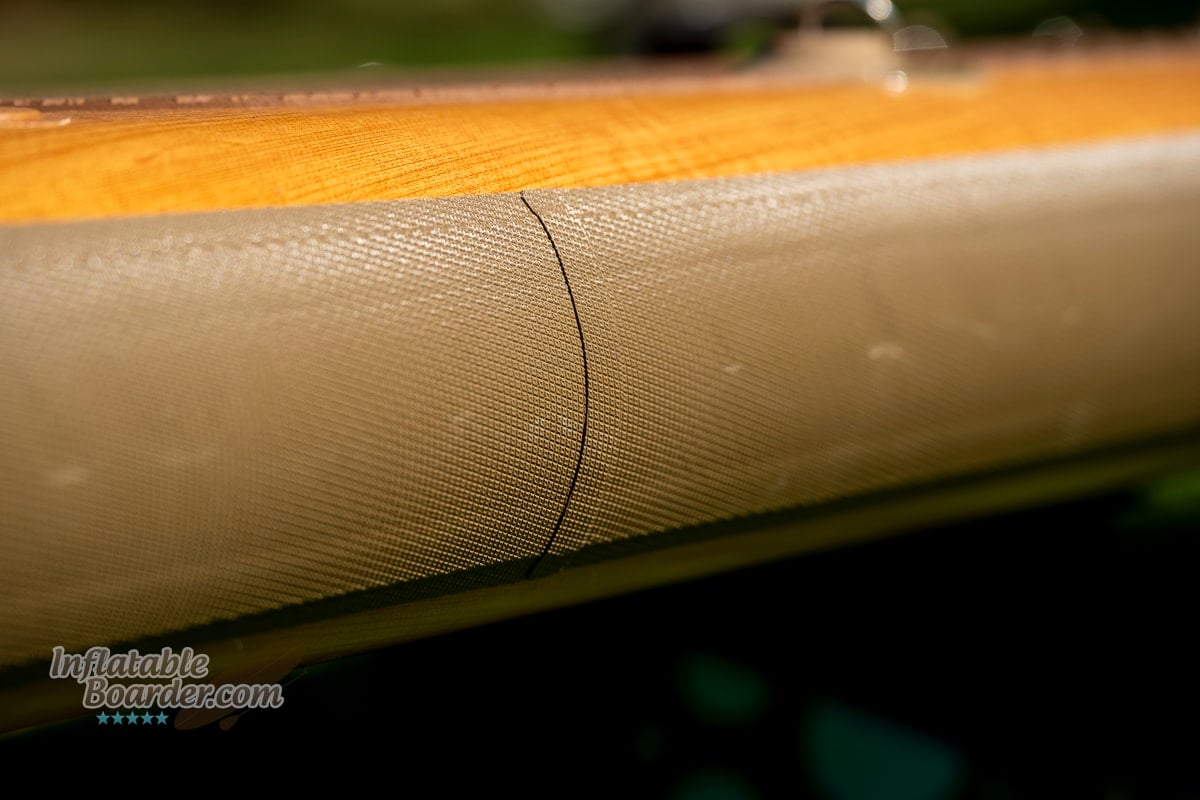
The Portager has an inner welded seam and an outer layer of PVC.
Inside the Portager, Paddle North uses a traditional knitted drop stitch fabric core to give the board its 6” thickness and flat shape. This fabric layer is coated with a liquid PVC material to seal the fabric and then act as an adhesive and mechanically bond a reinforced PVC tarpaulin to create the outer shell of the board. This process is done mechanically at the raw-materials stage which reduces the potential for manufacturing errors, glue usage, and weight compared to a hand-glued dual-layer construction.
Once the material is assembled, the shape of the board is cut and the sides are bound together with a welded PVC seam all the way around the sides of the board. Welding again reduces glue use and reduces the chance for manufacturing errors, but it also mechanically bonds the materials together into a single continuous material rather than relying on an adhesive. The outcome is lighter weight, and a stronger bond at the most critical construction point of the SUP.
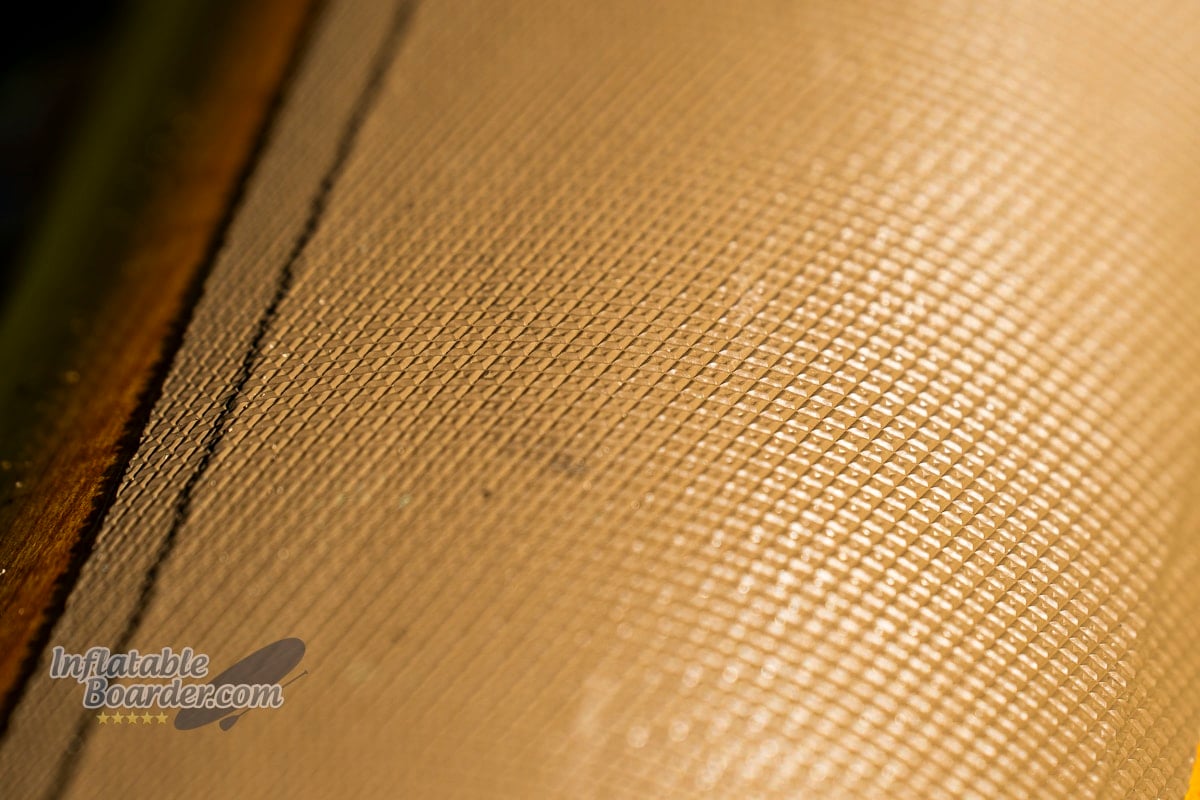
The Gliderail PVC outer rail is heavily textured to provide increased abrasion resistance without the need for additional materials and weight.
To finish off the construction of the paddle board, the Portager gets a second, outer, rail layer made with Paddle North’s Gliderail PVC material. This textured PVC layer helps protect the board against cuts and abrasion better than a thinner, flat, PVC material. Finally, the on-board features (D-rings, valves, fin boxes, etc.) are glued and installed on the board.
Alongside the Halkey-Roberts inflation valve, the Paddle North Portager also has a Pressure Relief Valve (PRV). This valve is designed to open and allow air escape once it reaches 18 PSI. Any additional pressure is vented automatically. The benefit here is it can protect your board against damage from accidental over-inflation from temperature changes or air compressors. On paper PRVs are a great idea.
How necessary or beneficial are PRVs in real life? Almost all iSUPs are tested by manufacturers and brands at pressures well exceeding their listed maximum recommended pressure. Faulty construction would make itself known very easily at even moderate pressures, much less high pressures. Board failures in high temperatures are primarily caused by a combination of softening materials and glues, plus the pressure inside the board.
Pressure Relief Valves, in my opinion, neither detract nor notably add to a board’s durability and longevity. They can offer a bit of peace of mind for paddlers in hotter climates or those who like to leave their boards inflated for long periods of time, but ultimately durability and longevity will come down to how well you care for your board in its entirety – including the valves as PRVs do add an additional mechanical component to any board.
All-in the Portager weighs 21.5 lbs on our scale – close enough for us to the 21 lb listed weight on Paddle North’s website. Considering the board’s size, that’s actually quite light, and it’s noticeable when carrying it. Together with the bag and other accessories, the entire package is only 35 lbs.
With lightweight constructions I do often worry about rigidity. It’s easy to make a rigid and heavy board, but difficult to make one that is rigid and light. I put the Portager up on the sawhorses for our static bend test and crossed my fingers as I piled on the weight. With 170 lbs of weight on the board, the Portager did really well, only deflecting 1.42” (3.6 cm) in our bend test. This is particularly good considering I was not able to perform the test at the maximum 18 PSI, but rather at only 16-16.5 PSI.

The Portager does not have any noticeable flex while standing and paddling normally.
Normally we do our bend test at an iSUP’s maximum recommended pressure. This gives us an indication of the best rigidity performance a board may offer. While inflating the Portager for the bend test I ran into a bit of a snag. I couldn’t get the board to inflate to its full 18 PSI. The Pressure Relief Valve was opening around 16.5 PSI (16-17 PSI depending which gauge I was using). To double check myself I used three different pumps (2 electric, 1 hand pump) and a stand-alone pressure gauge.
I followed up with Paddle North’s owner, Brennan Mogck, regarding the issue I was having with the PRV. He did indicate that the PRVs do have a ~1 PSI variation in their setting. Some PRVs have the ability to be manually calibrated from the outside (and Paddle North does have a video on how to do this) however not all of their products use this style of PRV. The valve on my Portager, unfortunately, can’t be manually calibrated. However, for customers with this valve experiencing this issue, Paddle North will send a replacement valve body to swap, or customers can request a full board replacement under the Paddle North warranty.

There is slight flex while sprinting and moderate flex while bouncing on the Portager.
On the water, the Portager displayed the exact amount of rigidity I expected after its bend test. With the full length of the board supported by the water, I didn’t notice any bend or flex while standing on the board and paddling casually. I did feel a little bit of flex while sprint paddling, though not much. By bouncing on the board I could generate a moderate amount of flex with a longer-lasting, but gentle, rebound after I stopped bouncing. All of this was with the board at my real-world maximum pressure of 16.5 PSI. With the board at its full, 18 PSI, pressure I fully expect it to be even more stiff in all conditions.
Specifications
| Dimensions | |
| Length | 11’ 6” |
| Width | 33“ |
| Thickness | 6“ |
| Weight | |
| Max Capacity | 350 pounds |
| Board Weight | 21.5 pounds |
| Kit Weight |
35 pounds |
| Buying Info | |
| List Price | $ |
| Warranty | 4 years |
| Returns period | 30 days |
Features, Accessories and Versatility
The Paddle North Portager is an all-around iSUP with a bit of a touring vibe. It’s not quite a crossover board, but it can certainly be used for shorter overnight trips as easily as casual cruising.
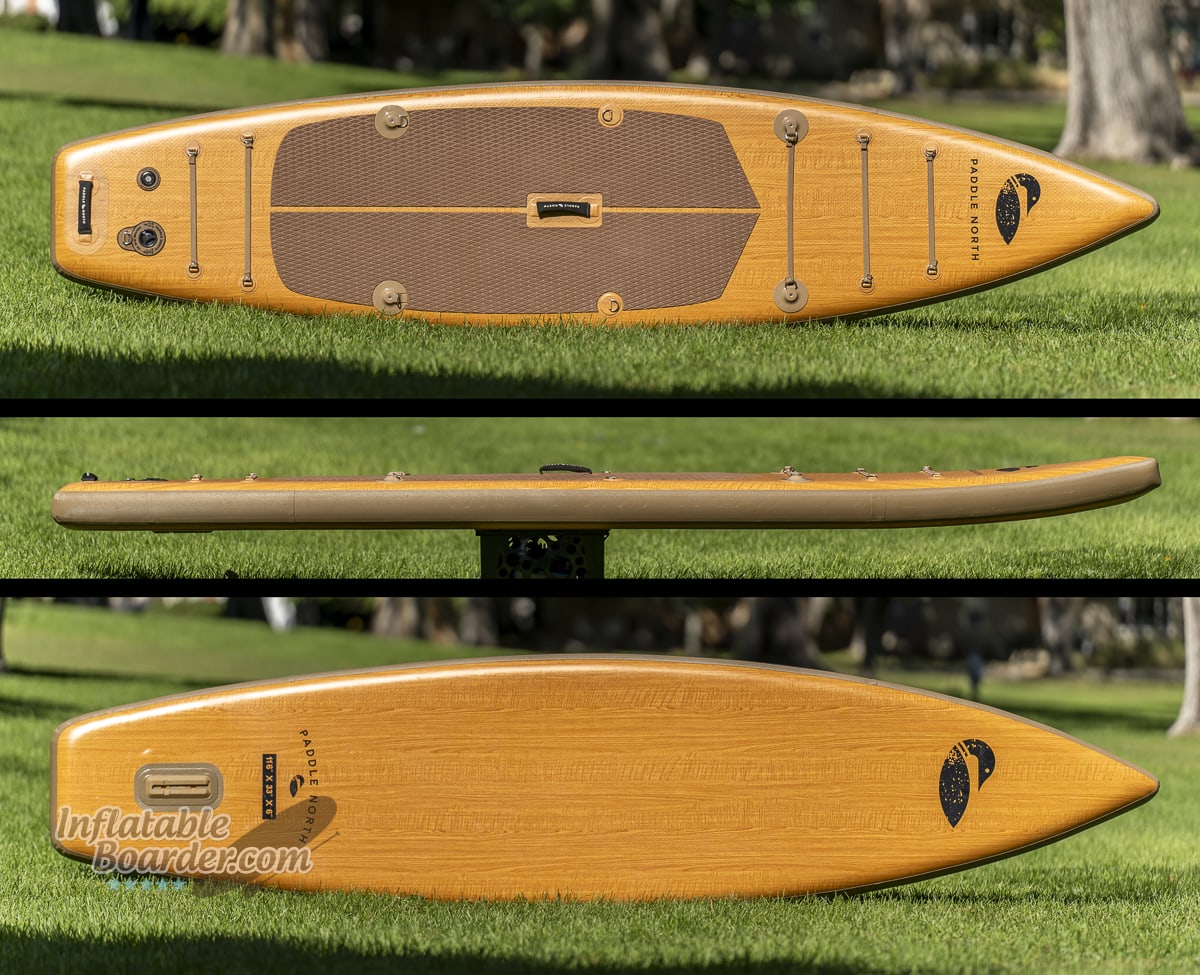
The Paddle North Portager is 11’6” long, 33” wide, 6” thick, and has a weight capacity of 350 lbs.
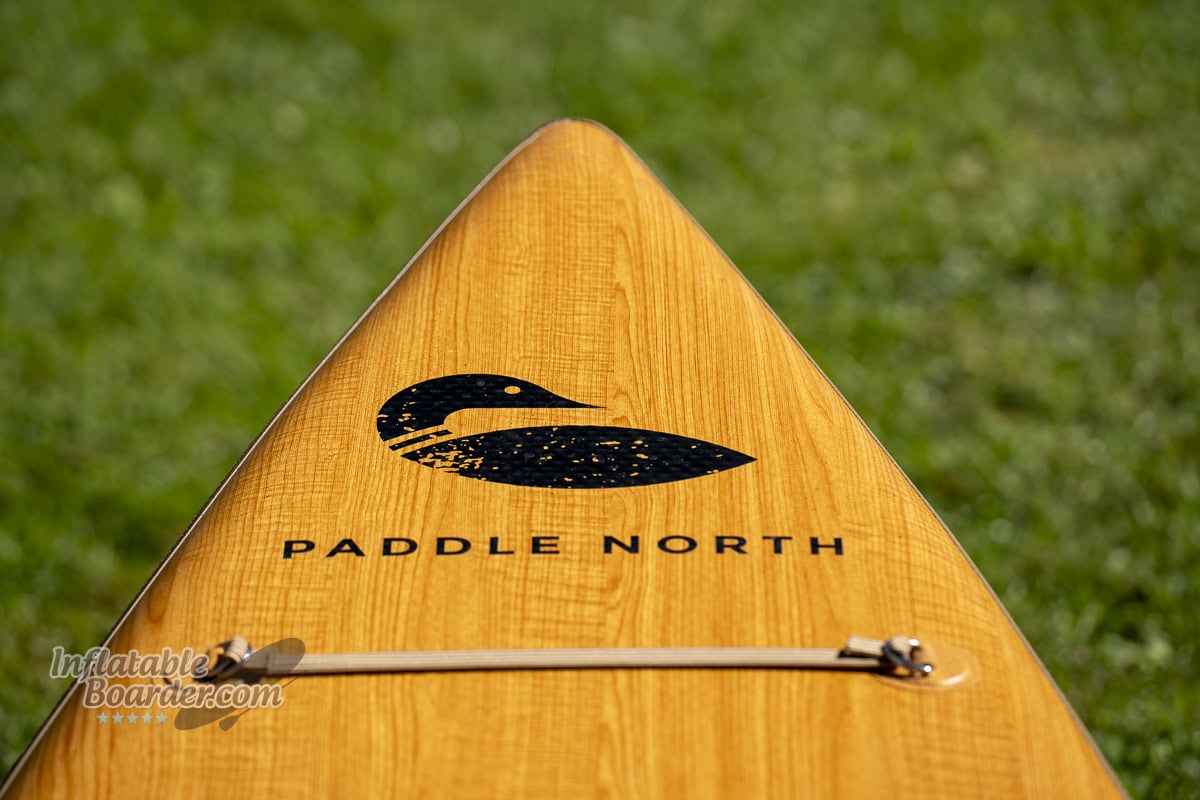
The nose of the board comes to a distinct point with a lower rocker profile to help pierce through choppy conditions and provide a clean entry point.
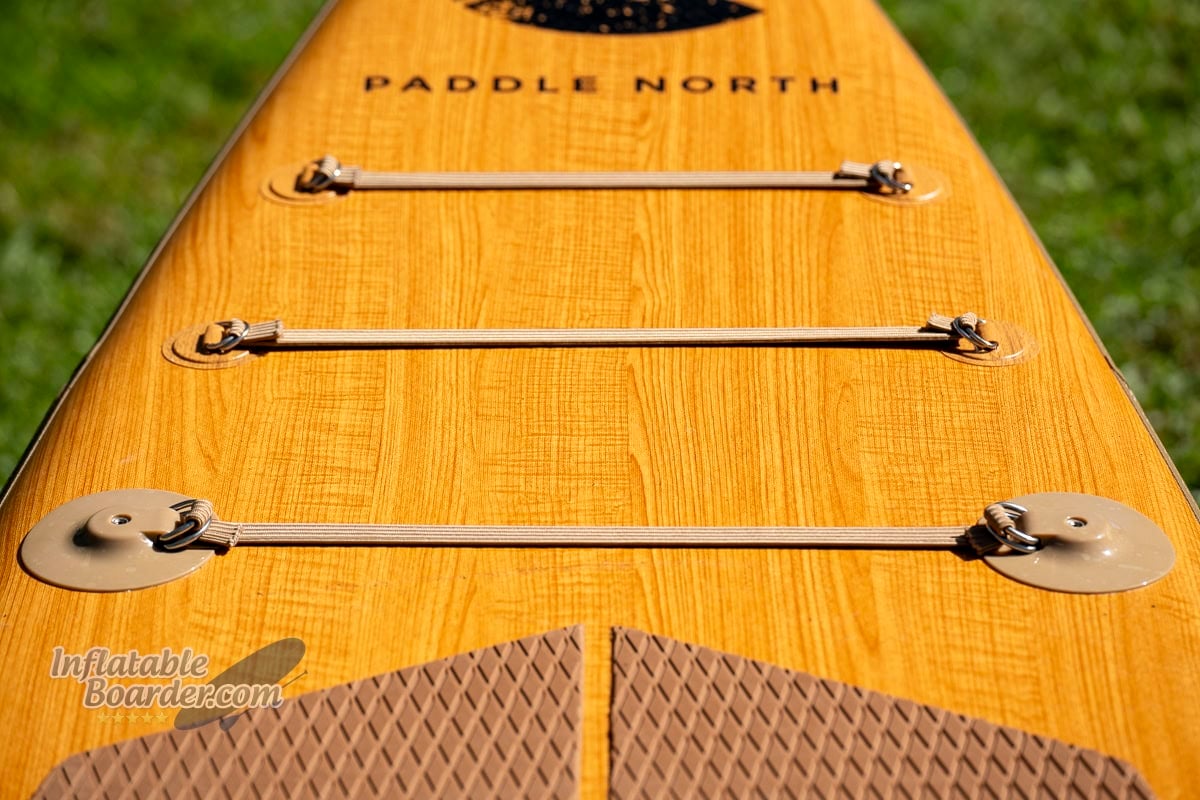
The front cargo area is strung between 6 sets of double D-rings using flat elastic webbing. The flat webbing easily holds items large and small and the straps quickly tighten down by pulling on the tail end of the strap.
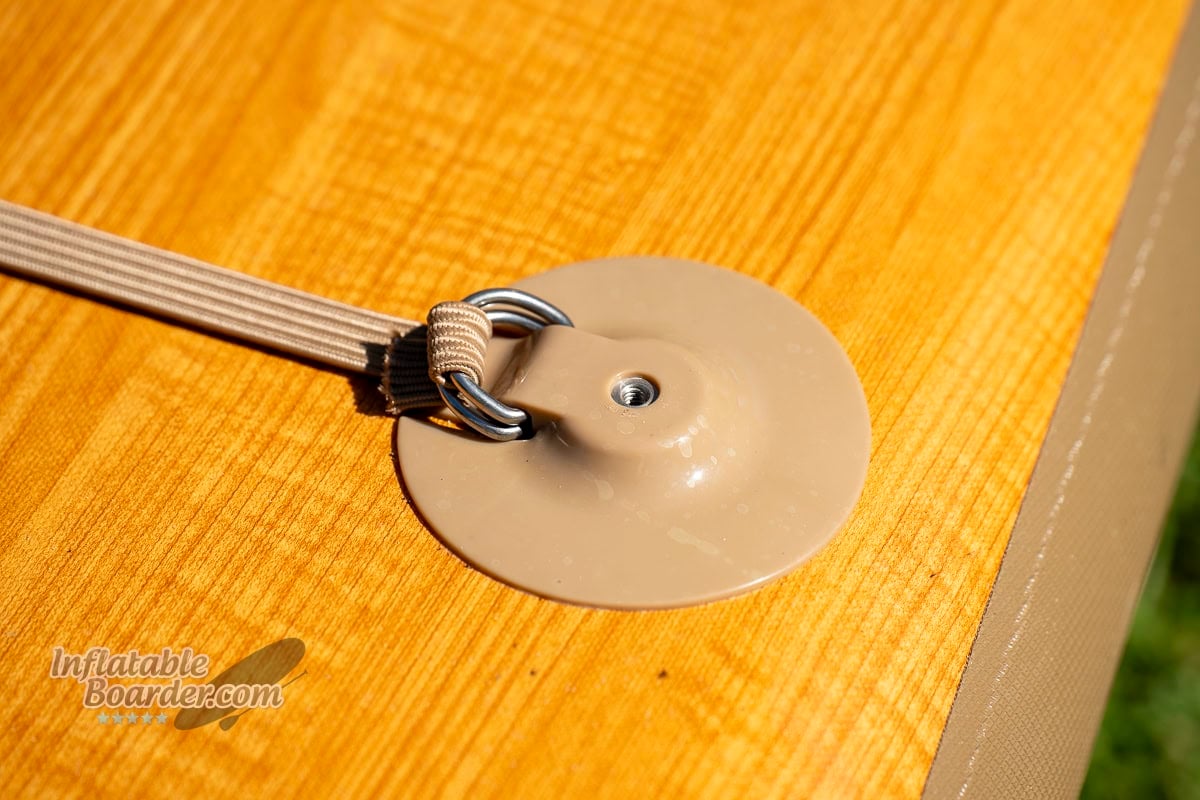
The two closest D-rings also have threaded accessory mounts for fishing rod holders, phone holders, cup holders, and more.
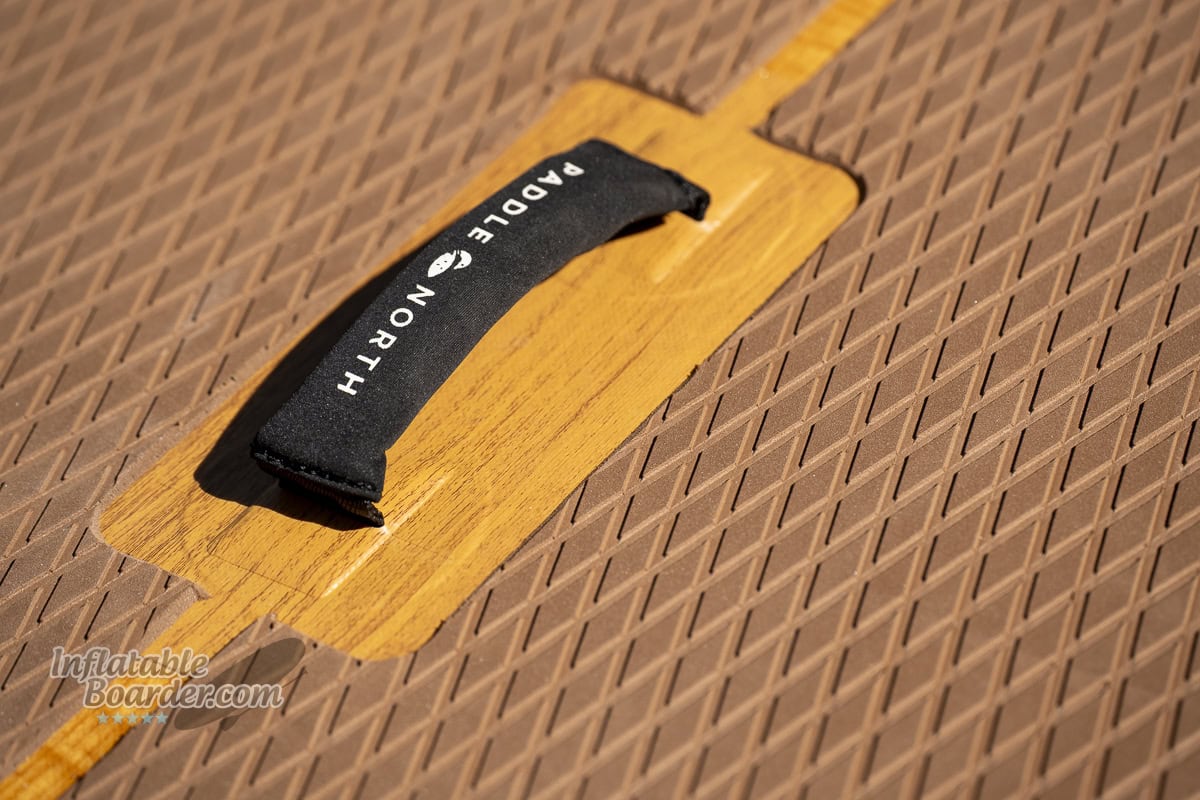
The foam deck pad features a light diamond groove texture that is comfortable on bare skin while still providing excellent traction. There is a small split down the middle of the pad for water drainage, however the pad is relatively short, ending a significant distance from the tail of the board.
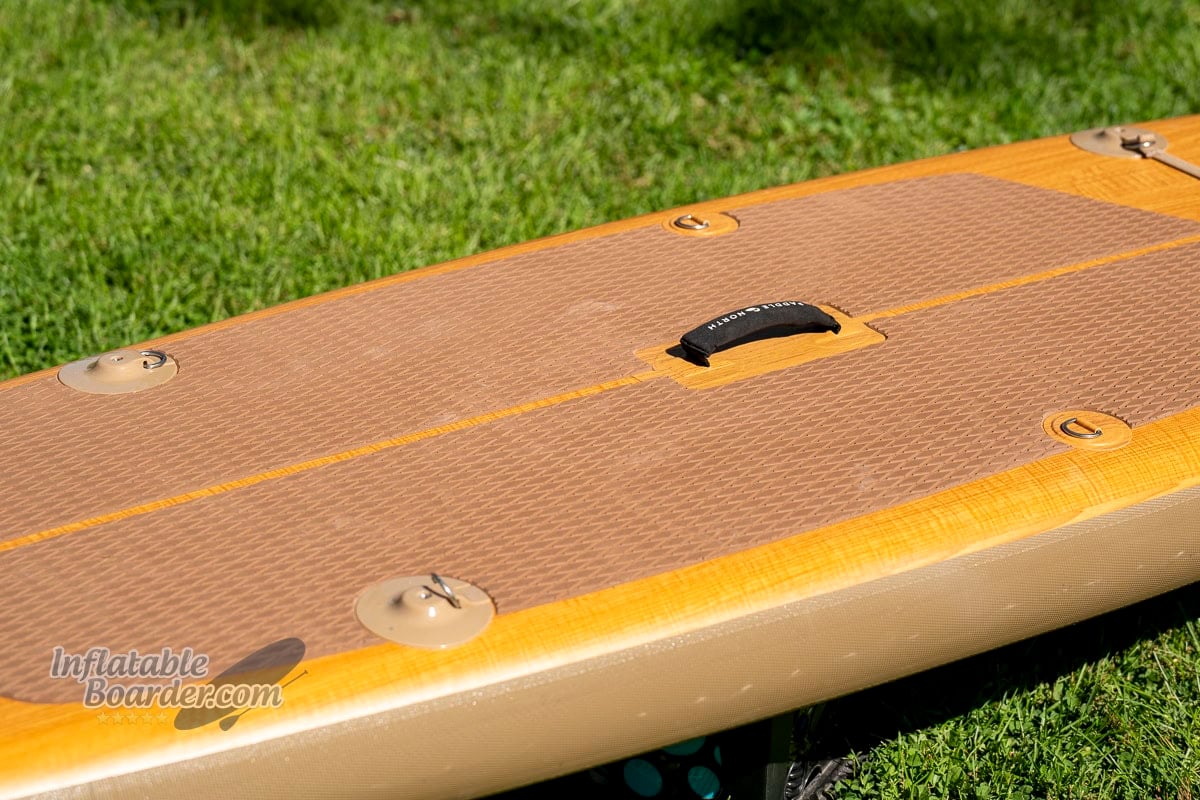
There are four D-rings around the middle of the board that can be used with a kayak seat attachment. The rear two D-rings also have threaded accessory mounting points built in.
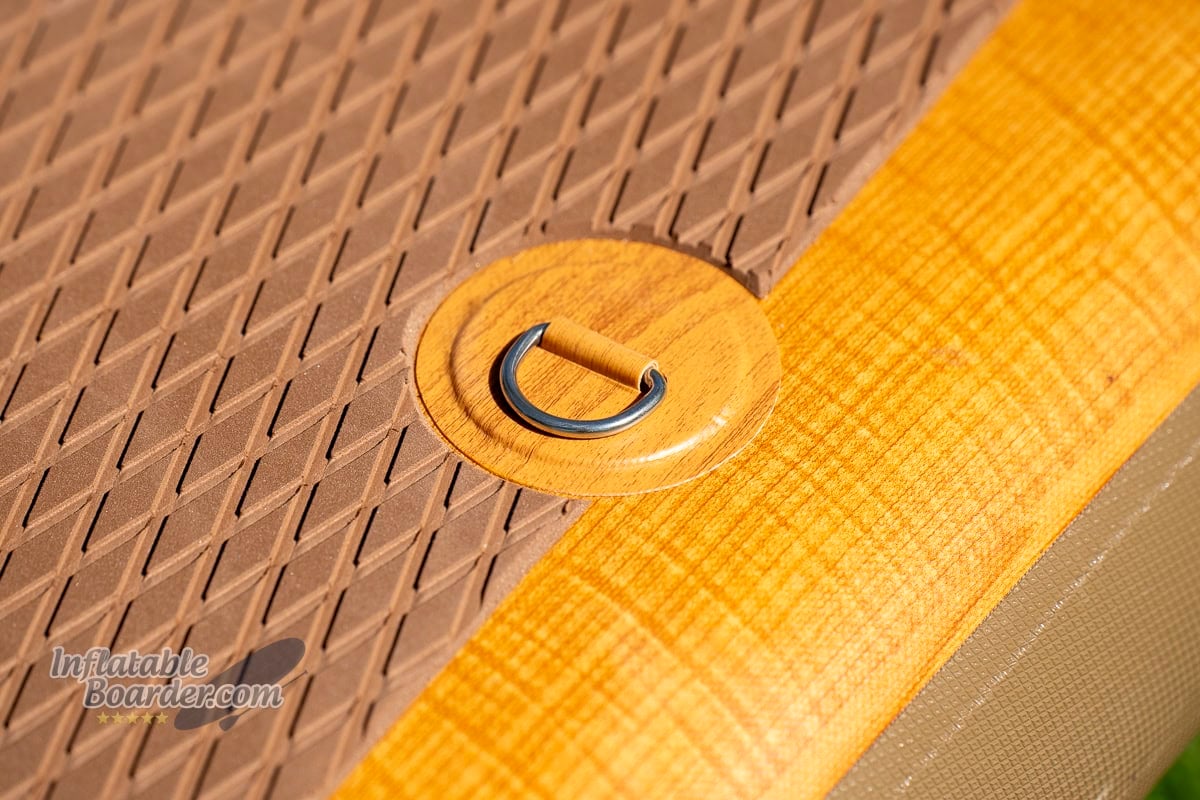
The overall construction of the board is quite nicely done with straight, clean lines at each glued joint, directionally matched “wood grain” on the D-ring patches, and even bevel-cut deck pad cutouts.
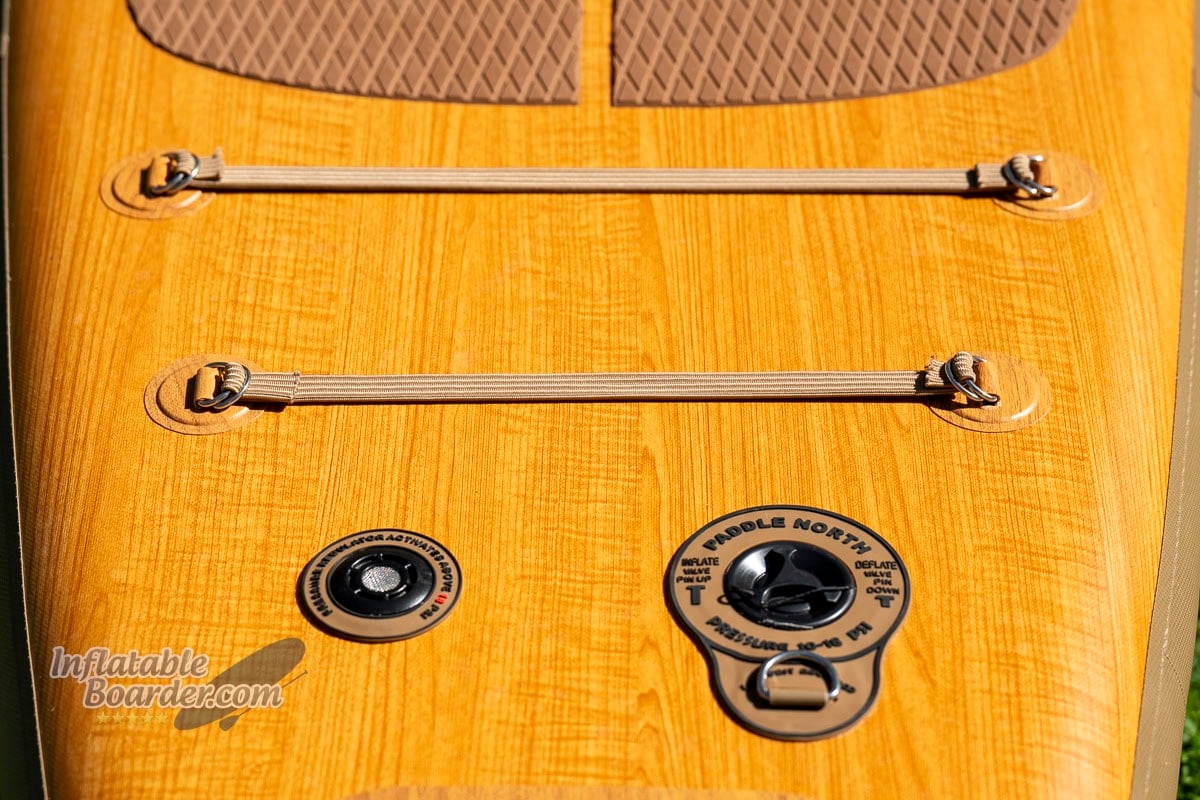
The rear of the board has two more cargo straps behind the deck pad, a pressure relief valve, inflation valve, and a leash D-ring, though the Portager does not come with a leash.
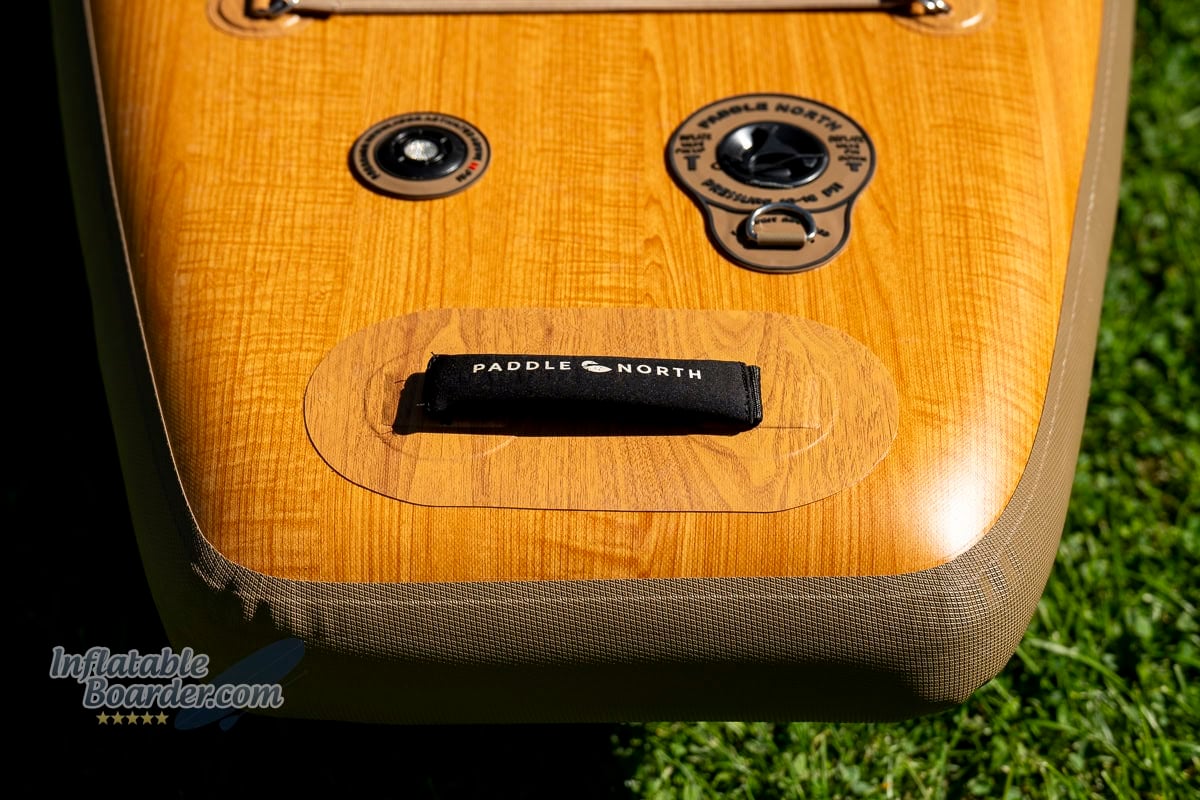
The tail also has an extra grab handle (though not one at the nose of the board) and the tail is quite wide with a square shape for improved stability.
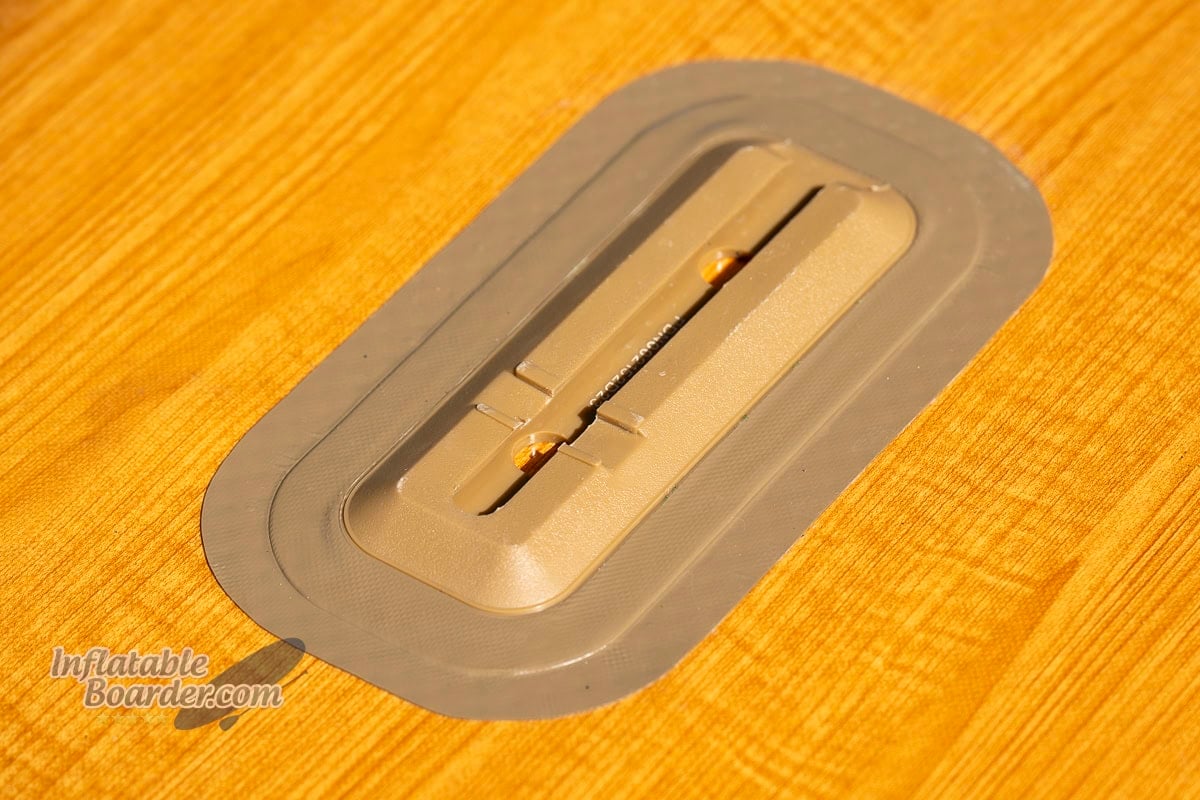
Under the board there is a single slide-in fin box. These are my second least-favorite style of fin box as there are few options for fins to begin with and the fin box is easily damaged by rolling or crushing.
With ample cargo storage, D-rings, and four threaded accessory mounts, it’s quite easy to pile the Portager full of camping equipment, fishing gear, or just about anything else you can think of.
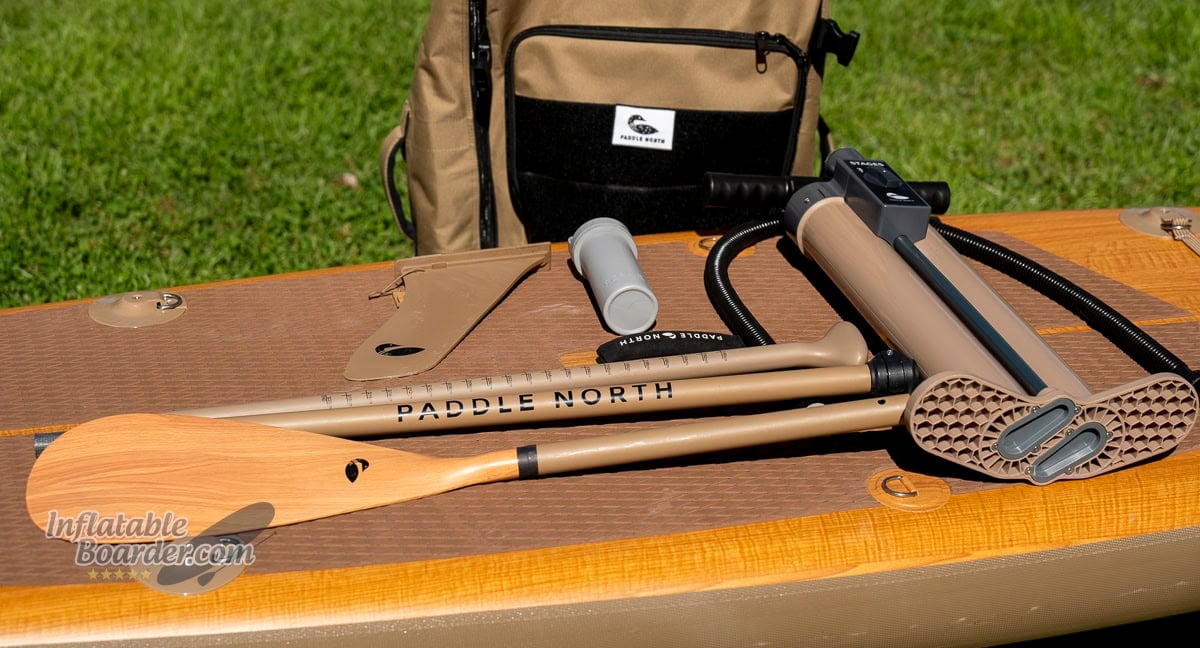
The Portager comes with nearly a full kit of accessories typically found with an iSUP except for a leash.
The Portager comes packed with a high-efficiency triple-action hand pump, fiberglass paddle, touring-style fin, and a repair kit. All of this fits quite easily into the wheeled backpack storage bag.
One thing the kit does not include is a leash. When asked about this, Paddle North indicated that the leash was left out to allow for customer choice and to reduce cost to the customer for a leash they may not want. While that may be the reason, to me it doesn’t make sense to sell a complete kit except for a very crucial (and inexpensive) piece of safety equipment.
Paddlers, even at advanced levels, hardly ever give thought to what type of leash they are using beyond a straight leash for surfing or a quick-release for river running, but will spend hundreds on selecting a better paddle – a much more important item to customize than a leash. If Paddle North truly wanted to commit to customer choice (as many other brands have begun doing) they should offer the Portager as a board-only option as well for the paddlers who want customization options, and sell it as a complete kit, including a leash, for those who want a turnkey package option.
Paddle
Paddle North includes a fiberglass and nylon 3-piece paddle with a wood grain pattern that matches the Portager’s PVC shell.
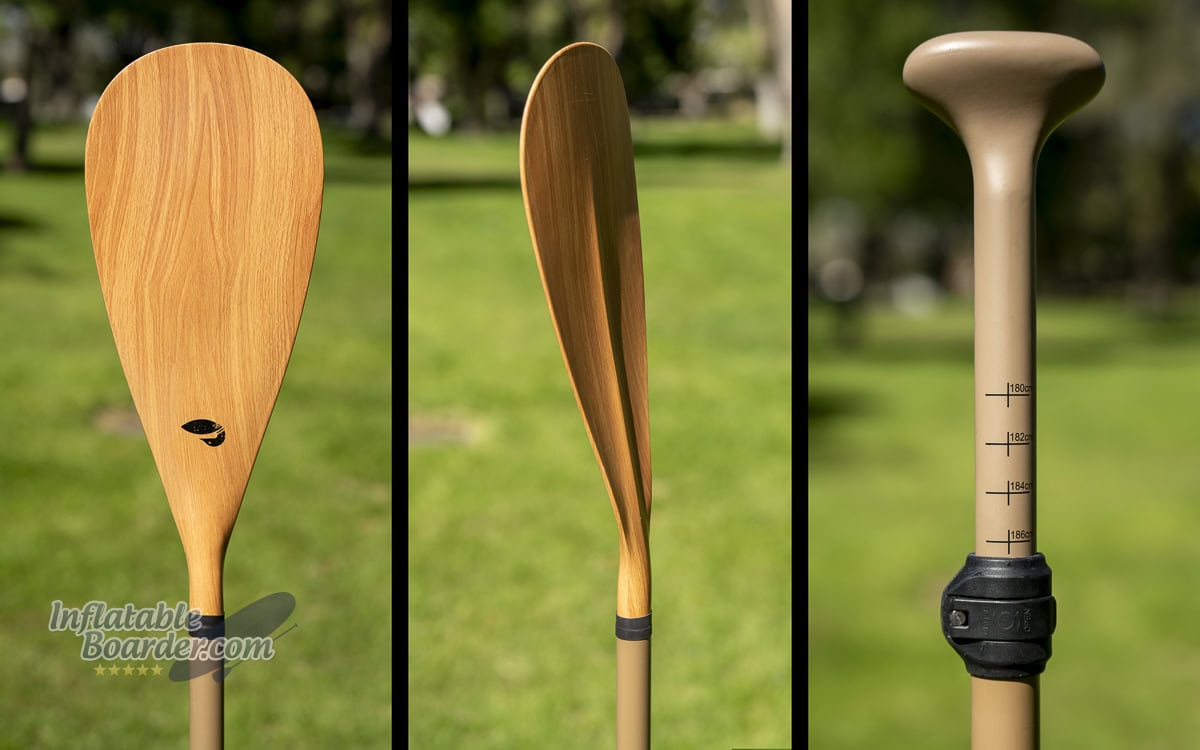
The blade features a pronounced dihedral ridge to reduce flutter and wandering in the water.
At just over 32 ounces, the Portager’s fiberglass paddle sits in the middle range of weight for kit paddles, but has a balanced feel in the hand. The plastic blade is moderately stiff with a very pronounced dihedral ridge down the middle of the power face. This ridge helps direct water evenly across the paddle face and reduces fluttering (twisting) and wandering (sliding) in the water. The blade is a medium size with a slightly elongated teardrop shape. This makes it easy to use for casual paddling and longer distances, however it’s not ideal for very fast paddling.
The shaft and handle sections are made of fiberglass with a smooth matte finish. Fiberglass offers a great balance between weight, rigidity, and cost. It’s far more durable than aluminum and nearly as light as carbon fiber, but without the added cost. It has just a small amount of flex in the shaft that, combined with the flex in the blade, makes it comfortable to use for longer periods of time.
The handle section is also made of fiberglass with a molded handle and indexing groove. There is a length scale along the front of the handle to easily set the paddle at your preferred length each time, and the indexing groove keeps the handle correctly oriented with the blade.
Stability
The Portager provides good stability for paddlers of all skill levels thanks to its wide shape in the rear of the board.

When I first saw the Portager I had a few reservations about its stability. Often, paddle boards with dramatically “torpedo” shapes suffer from stability issues. However the Portager’s wide, square tail has increased its stability and is actually quite comfortable on the water. The Portager is a full 33” wide at its wide point – just in front of the front kayak-seat D-rings. This puts the standing position just behind the wide point, though when leaning forward to paddle, your center of gravity does fall closer to this most stable section of the board.
The front of the board tapers quickly, so very heavy cargo or passengers should be kept back toward the middle of the board to keep it more stable. The Portager does taper toward the tail almost immediately behind the wide point, but instead of tapering to a point, the board ends with a square tail that’s 22” wide a foot from the end of the board. Square tails, particularly when they are this wide, give a board increased stability compared to round or pin tails.
I had no issues standing, paddling, and moving around on the Portager, though I could tell that moving toward the tail was less stable than in the standing area. The deck pad provides really good traction, but it does end a few feet before the tail of the board. At 230 lbs I was able to lift the nose of the board just enough to quickly pivot turn by standing at the very end of the deck pad, however lighter paddlers may have difficulty doing so without needing to step onto the bare PVC at the tail of the board.
In choppier conditions and when the board is tilted on its side the Portager is easy to maintain balance. While it’s not as stable on its rail as more parallel shaped boards, once again the wider tail keeps things manageable, allowing you plenty of time to correct and rebalance the board. When rocking the board back and forth I found it to dip under the water and resurface easily and predictably as well.
Overall the Portager has good stability performance for paddlers of any skill level. Beginners will appreciate the extra width and square tail and intermediate/advanced paddlers will still find it to be enjoyable to paddle without being so large and blocky that it feels sluggish in the water.
Speed
The Portager did moderately well in our speed test, especially given its width, but it did have a nice smooth, gliding, feel when paddling at moderate speeds that was quite enjoyable.

The Portager has good speed performance in all categories for a wider board.
With a maximum width of 33” and a tapered shape I wasn’t exactly sure how the Portager would do in our sprint test. Wider boards tend to be a little slower, but with the tapered nose and rigid construction I had some hope. Overall the Portager did well in our testing – not the fastest, but certainly not sluggish. In our sprint test the Portager averaged 5.3 MPH for a sustained sprint speed and had a peak speed of 5.5 MPH. This is pretty much in-line with other all-around iSUPs, but not as fast as crossover and touring iSUPs. One thing I didn’t notice was any major flex in the board while sprinting, even at the slightly lower than maximum pressure I was able to use the board.
The rocker in the nose of the board is a little bit lower than many other all-around iSUPs, but it did a great job of parting the water and keeping it off the deck of the board rather than pearling and allowing water to build up on the deck like some other low-rocker boards.
The Portager easily cruises along at an average of 3.6 MPH with a casual paddling cadence (25 strokes per minute – pausing slightly between continuous strokes). When paddling at a more casual pace I found myself really enjoying the feel of the board in the water. It did seem to glide really well. When I measured the glide of the board I was able to move an average of about 19.5 feet with each stroke before slowing down. That gives it a glide ratio of 1.7 board-lengths per stroke. While not quite at the level of a touring board, that is really good for an all-around iSUP.
Overall the Paddle North Portager is quick when you want it to be, efficient on the water, and just a fun board to paddle at any speed.
Maneuverability and Tracking
One of the most prominent performance features that Paddle North brings up on the Portager’s web page is its tracking performance – claiming that the nose shape helps improve tracking, letting you paddle up to 25 strokes per side. That’s quite the claim! So let’s see how the Portager did in our maneuverability and tracking performance tests.

The Portager has average maneuverability when using basic turning strokes.
Being able to turn your board is one of the first fundamental skills all paddlers need to learn. After all, if you can’t point your board where you want to go, it doesn’t matter how good your forward stroke is! How quickly a board will turn is based on its length, shape, fin setup and types of fins. With a slightly longer waterline, but a wider shape and only a single fin, until I got the Portager on the water I could only guess as to what it would do!
In our maneuverability test we use forward sweep strokes to turn the board in a full circle from a standstill. This mimics the most common turning stroke used, especially by beginners, and doubles as a stress test as the forward sweep is also one of the least efficient turning strokes you can use (paddling in an arc from nose to tail). In this case, the Portager needed an average of 6.75 strokes to make a complete circle. That’s a little lower than average for an all-around board, but better than a touring iSUP.
Now, putting that stroke in reverse turns the board much more quickly at just 4.25 strokes to make the same full circle. However, this reverse sweep stops all forward momentum you may have, so it’s not always the best option.
Stepping back on the board to make a pivot turn is a little interesting. The deck pad stops well short of the tail of the board. As a heavier paddler I was still able to lift the nose of the Portager a little bit with my foot at the very edge of the deck pad, but lighter paddlers may struggle to do so.

The Portager has also average tracking performance compared to other all-around iSUPs.
While the Portager did pretty well in our maneuverability testing, I was anticipating our tracking test the most. Paddle North claims that the Portager’s “displacement hull” nose helps greatly improve its tracking ability – up to 25 strokes on a side before needing to switch, which is incredibly high and instantly triggered my skeptic alarm. They even made a video showcasing a paddler taking over 20 strokes on one side of the Portager. That all sounds pretty good until you take a closer look at the video. First, there’s no stationary reference to see if the board is going straight or not, it’s just an overhead drone shot of the board surrounded by water. Second, by about stroke 8 you can easily see the board pushing away from the paddle on each stroke. It’s at this point that you can also see the paddler incorporating a bow-draw at the beginning of each stroke in order to keep the board pointed more or less in the original direction. If we use a combination bow-draw-forward-stroke then a skilled paddler can paddle indefinitely on one side of almost any SUP and go in a straight line, so now I’m even more skeptical of this tracking performance claim. But enough video analysis, how did the Portager do in the test?!
Our tracking test is done by paddling the board at cruising speed toward a distant target. Once the board is on track (evenly alternating sides every 3-4 strokes to really get it going straight), we take 10 forward strokes on a single side. These are “strict” forward strokes with no adjustments or combo strokes being made to steer the board on course. After the 10th stroke, we identify the board’s new course and measure the difference between the new and original course using a sighting compass. All of our maneuverability, tracking, and speed testing is done in extremely calm conditions in order to minimize environmental impacts on the test and provide a fair comparison from test to test. This method has proven to be wildly consistent and accurate for us over the past year.
After 10 paddle strokes on a side, the Paddle North Portager had an average deviation of 19°. This deviation is on the higher side of average for an all-around board according to our testing. So I repeated the test again to be sure, then I did it a third time on another day all to the same conclusion. With this level of tracking I have to say the Portager, unfortunately, won’t be making the list of “best tracking” iSUPs available.
But…
Even with the less-than-hoped-for result of the tracking test, the Portager does still track well in real-life use. It’s not a straight-line wizard, but for the casual paddler who is typically taking 6-8 strokes on a side at most, it does well. If you can incorporate a little bit of paddle blade angle in your stroke or even a full combination bow-draw-forward-stroke then it does quite well, and it is easy to steer on course for long periods of time.
So what is the disconnect here? Well first let’s go back to shape of the board. While 11’6” is long for an all-around SUP (which can help with tracking) the 33” width forces the paddle blade to be farther from the midline of the board. Further, the pointed nose shape encourages paddlers to place the paddle blade close to the board, and then keep it along the rail making essentially a curved shape through the water. Paddle boards that are narrower and have more parallel sides don’t encounter this issue as much since the paddle is closer to the midline and maintains a straighter course in the water.
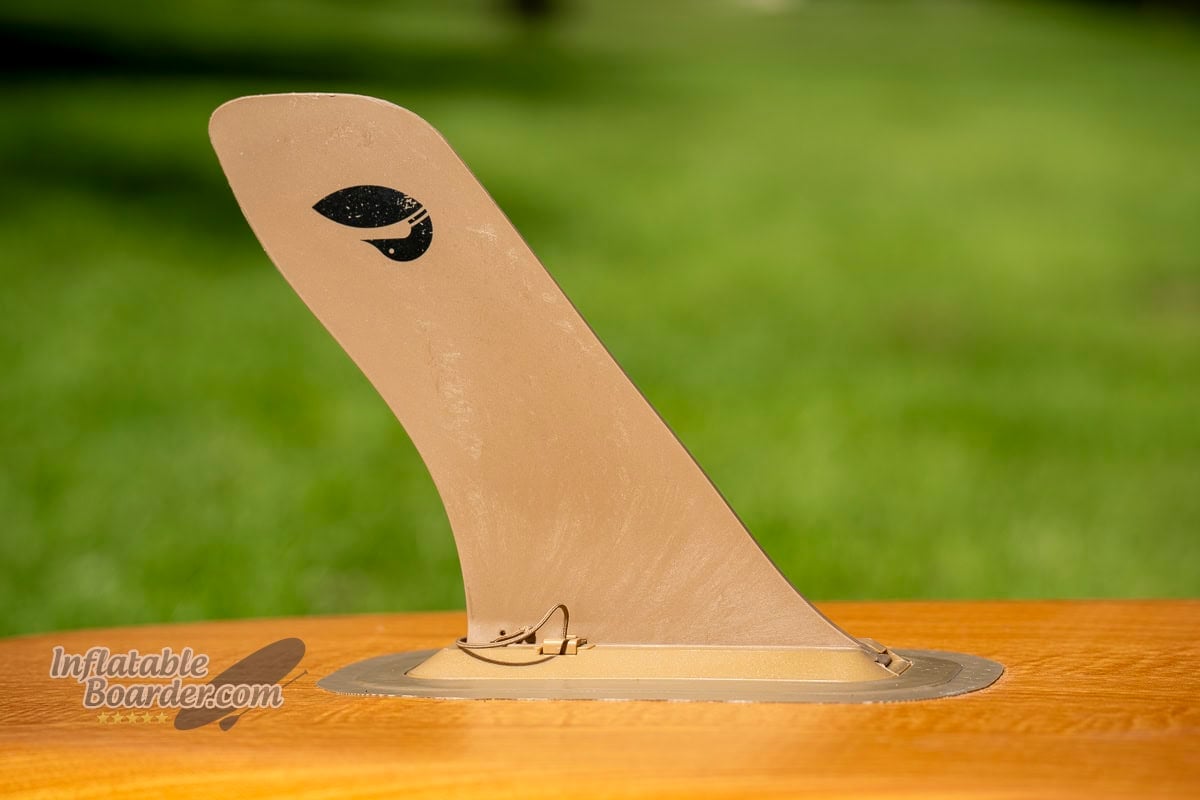
The 10” touring-style fin helps the Portager track straighter and offers more stability than a traditional surf-style fin.
Next is the fin. The Portager comes with a 10” touring-style fin. This is a great shape and size to encourage better tracking. However, it could be improved with one of two changes. First is the position. There’s enough room on the Portager’s hull to move the fin position significantly further to the rear of the board. Doing so would greatly improve the tracking capability using the same single-fin setup. The other thing that could improve the tracking would be to move to a twin-fin setup similar to the Red Paddle Co. Voyager or the Blackfin XL Ultra. Granted, both of these changes would also reduce the maneuverability performance. However, if the focus of the board is going to be on tracking performance, then hopefully one or both of these changes will be implemented in the future.
The Portager uses a slide-lock style fin and fin box. This is one of my least favorite styles of fin box (though the true title of “fin boxes I’d never choose to use if I didn’t have to” is the J-hook fin box). There are very few options for fin selection and availability, and durability is a concern in my experience. The slide-lock system is very easy to use. However, I’ve had slide-lock fin boxes completely collapse on themselves where the fin enters the box, and the fin boxes can easily be rolled out of shape making it nearly impossible to insert or remove the fin without a hammer (I destroyed two Hydro Flask-style water bottles hammering slide-lock fins before I started keeping a hammer in the car). I would absolutely love to see the Portager get an upgrade to a standard US fin box for increased durability and the ability to use thousands of different fins available at any surf or SUP retailer.
Warranty and Customer Support
The Paddle North Portager is built extremely well with machine-laminated fusion PVC and welded interior seams. However if you do have any issues with your board, the Portager is covered by a 4 year warranty. The Paddle North accessories are also covered by a 2 year warranty – which is, I believe, the longest warranty on accessories around. If for some reason the Portager isn’t what you thought you wanted, Paddle North does offer a 30-day return period for equipment that is unused or in like-new condition (no signs of use). If you have any questions about the Portager or Paddle North, you can contact them via their website, live chat, email, phone, at one of their retail stores (MN, MI), or through social media.
Overall Impressions/Review Summary

The Paddle North Portager is a great all-around iSUP with plenty of versatility on the water.
The Paddle North Portager is an all-around iSUP that blends extremely pleasing aesthetics with high-quality construction to create a well-performing board. It’s got good stability for beginners, a nice, efficient feel on the water when you are going the distance, and plenty of storage and accessory mounts for an afternoon, day, or even an overnight trip. The welded seams and Gliderail PVC rail material position the Portager to be a long-lasting board, and it’s backed with an excellent 4 year warranty. While there are a few things I would like to see improved with the Portager for the next generation, overall I think any paddler looking for a high quality do-it-all style iSUP will be very pleased with the Paddle North Portager.
Paddle North Portager iSUP FAQ
Can I bring a passenger or dog with me on the Paddle North Portager iSUP?
Yes. The Portager has plenty of stability and volume for an adult with a child passenger or medium size dog, however you’ll want to consider the amount of available space. The deck pad is relatively small, and the tapered shape can reduce stability if either rider is too far forward or back on the board.
Is the Paddle North Portager iSUP compatible with a kayak seat?
Yes, the Paddle North Portager iSUP is compatible with a kayak seat attachment, however the included paddle is not compatible with a second blade.
How does the Pressure Relief Valve work on the Paddle North Portager iSUP?
The Pressure Relief Valve (PRV) automatically opens and releases air when the pressure inside the board increases above 18 PSI. There is approximately 1 PSI variability in the valve, so it may open slightly lower or slightly higher than 18. Once the pressure inside the board has lowered back down, the valve will automatically close again.
How long does it take to inflate the Paddle North Portager iSUP?
Not long at all. The included triple-action hand pump is very fast and can inflate the Portager to 15 PSI in around 8 minutes (or less depending on how quickly you pump).



Leave a Reply